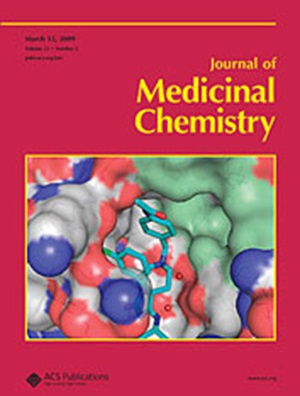Structure of Mycobacterial NDH-2 Bound to a 2-Mercapto-Quinazolinone Inhibitor
IF 6.8
1区 医学
Q1 CHEMISTRY, MEDICINAL
引用次数: 0
Abstract
Mycobacterial type II NADH dehydrogenase (NDH-2) is a promising drug target because of its central role in energy metabolism in Mycobacterium tuberculosis and other pathogens, and because it lacks a known mammalian homologue. To facilitate optimization of lead compounds, we used electron cryomicroscopy (cryo-EM) to determine the structure of NDH-2 from Mycobacterium smegmatis, a fast-growing nonpathogenic model for respiration in M. tuberculosis. The structure shows that active mycobacterial NDH-2 is dimeric, with an arrangement of monomers in the dimer that differs from the arrangement described for other prokaryotic NDH-2 dimers, instead resembling dimers formed by NDH-2 in the eukaryotes Saccharomyces cerevisiae and Plasmodium falciparum. A structure of the enzyme bound to a 2-mercapto-quinazolinone inhibitor shows that the compound interacts directly with the flavin adenine dinucleotide cofactor, blocking the menaquinone-reducing site. These results reveal structural elements of NDH-2 that could be used to design specific inhibitors of the mycobacterial enzyme.

分枝杆菌 NDH-2 与 2-巯基喹唑啉酮抑制剂结合的结构
分枝杆菌II型NADH脱氢酶(NDH-2)是一个很有前景的药物靶点,因为它在结核分枝杆菌和其他病原体的能量代谢中起核心作用,而且由于它缺乏已知的哺乳动物同源物。为了优化先导化合物,我们使用电子冷冻显微镜(cryo-EM)来确定耻垢分枝杆菌NDH-2的结构,耻垢分枝杆菌是结核分枝杆菌中快速生长的非致病性呼吸模型。结构表明,活性分枝杆菌NDH-2是二聚体,其单体在二聚体中的排列不同于其他原核生物NDH-2二聚体的排列,而类似于真核生物酿酒酵母和恶性疟原虫中NDH-2形成的二聚体。与2-巯基喹唑啉酮抑制剂结合的酶的结构表明,该化合物直接与黄素腺嘌呤二核苷酸辅助因子相互作用,阻断甲基萘醌还原位点。这些结果揭示了NDH-2的结构元素,可用于设计分枝杆菌酶的特异性抑制剂。
本文章由计算机程序翻译,如有差异,请以英文原文为准。
求助全文
约1分钟内获得全文
求助全文
来源期刊

Journal of Medicinal Chemistry
医学-医药化学
CiteScore
4.00
自引率
11.00%
发文量
804
审稿时长
1.9 months
期刊介绍:
The Journal of Medicinal Chemistry is a prestigious biweekly peer-reviewed publication that focuses on the multifaceted field of medicinal chemistry. Since its inception in 1959 as the Journal of Medicinal and Pharmaceutical Chemistry, it has evolved to become a cornerstone in the dissemination of research findings related to the design, synthesis, and development of therapeutic agents.
The Journal of Medicinal Chemistry is recognized for its significant impact in the scientific community, as evidenced by its 2022 impact factor of 7.3. This metric reflects the journal's influence and the importance of its content in shaping the future of drug discovery and development. The journal serves as a vital resource for chemists, pharmacologists, and other researchers interested in the molecular mechanisms of drug action and the optimization of therapeutic compounds.
 求助内容:
求助内容: 应助结果提醒方式:
应助结果提醒方式:


